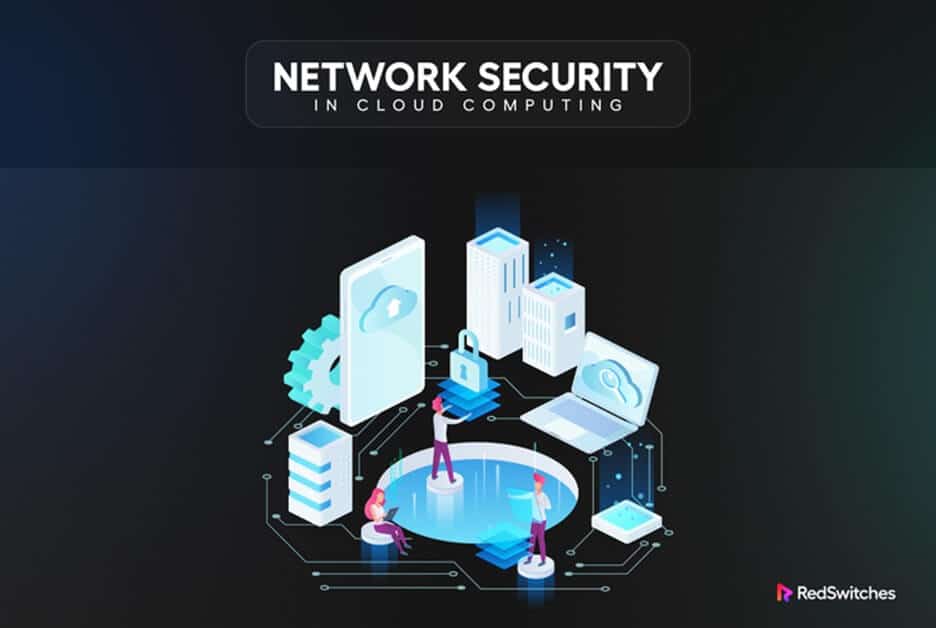How can a user ensure that their data in the cloud is secure from cyber threats? It is a common worry that most cloud users go through daily. The cloud has transformed how businesses process, store, or share their info and data. Recent research found that by the end of 2023, public cloud services will grow by over 20%. However, there are risks associated with network security in cloud computing.
The question becomes, how can a user protect their data from cyber-attacks? How can they comply with the set data privacy standards in the cloud? These are some queries that company heads ask themselves.
In this guide, we’ll answer these questions and examine the strategies to help businesses have strong network-level security in cloud computing. We’ll also explore the emerging trends and pitfalls and offer tips on how to navigate through them. The goal is to help you understand the concepts of cloud computing network security and how to apply them in your system.
Table of Content
- How Does Cloud Network Security Work?
- Why Is Cloud Network Security Important?
- Different Types of Network Security
- What Are the Benefits of Cloud Network Security?
- What Are the Challenges Faced in Cloud Network Security?
- Strategies to Minimize Risk in Cloud Network Security
- Types of Cloud Security Solutions
- Key Takeaways
- FAQs
How Does Cloud Network Security Work?
Cloud systems employ SDN to direct data traffic through a company’s cloud resources. The work of cloud network security solutions is to merge with virtualization and cloud systems. It helps to use virtual protection portals to protect network traffic.
The protection gateways work similarly to local storage security systems. One of the main differences is that they’re virtual and in the cloud.
Some of its key features are:
- Segmentation: Cloud computing in network security allows for segmentation in cloud systems. It is a crucial component in lowering company cloud vulnerability and the lateral movement of a hacker.
- Automation: Any manual processes can be vulnerable to human error and cyber threats. Automation is crucial in ever-growing cloud systems because they allow immediate threat response and scalability.
- Integration: Most cloud security solutions integrate a service provider’s resources and tools. They help to automate security and network monitoring.
- Traffic Inspection SSL/TLS: Mostly, you will find the network traffic to be heavily encrypted, making detecting malware difficult. Cloud network security offers traffic inspection with low latency.
Why Is Cloud Network Security Important?
User can reduce their cloud security challenges in many ways, which is why it is essential.
1. Reduces Business Risk
Network security provides enterprise-level protection for cloud resources. It means operating remotely becomes more secure and more manageable. It helps company teams collaborate better and improve productivity.
2. Reduces Costs
The cloud infrastructure is not expensive for customers because they don’t have to buy them. You only use cloud services offered by a provider and pay through a subscription model. Implementing cloud computing or network security will safeguard you from cyber-attacks and reduce the cost of data recovery.
3. Data Protection
Cloud computing network security helps protect user data from cyber-attacks and shields against misconfigurations and human errors.
4. Increases Reliability and Availability
Cloud services need to be available to customers around the clock. To ensure this availability, you must first employ network security measures to prevent downtime due to a breach. In addition, network security helps build customer trust because it shows commitment to protecting their data.
5. Ensures Regulatory Compliance
How you implement your private cloud environment is the critical element in meeting cloud security compliance. A compliance management platform can help you leverage solutions while connecting them to your business risk and regulatory requirements. For example, in the healthcare industry.
Different Types of Network Security
You can use some tools in your line of service for data protection. Some of the common ones include:
1. Antivirus and Antimalware Tools
A common form of cyber attack is malware, which infiltrates and corrupts user files. When a user experiences a malware attack, the best way to counter it is by installing an antivirus like Kerperskey. It scans your file system and removes all threats.
2. Application Security
Updating your system security can be the first step in protecting your data from attack. Combining antiviruses and best practices can help patch security gaps in a platform.
3. Behavioral Analytics
Creating a system that monitors user behavior is crucial to an organization, and here is why. When staff or devices access a cloud system, monitoring use and behavior is easy. If they’re irregular behavior like unauthorized access, it can indicate a system breach. Having such systems can help to prevent any threat early.
4. Data Loss Prevention
They are company measures that protect its sensitive data from breaches by staff. These networks prevent rogue employees from downloading, printing, or sharing company information and sensitive data.
5. Access Control
It’s when a company limits access to sensitive information to only authorized people. Companies accomplish it by applying security policies restricting access to specific networks or system sections.
What Are the Benefits of Cloud Network Security?
Companies have several benefits when they implement cloud computing and network security. Expected cloud security benefits include:
1. Consistent Policy Enforcement
Security policy enforcement across different environments can challenge companies due to the various structures. However, network security in cloud computing eases the management and update of the policies.
2. Advanced Threat Prevention
A cloud user can pick a package from their preferred provider with the best security measures. Enterprise-level plans often offer the best protection any business can find suitable to protect its systems.
3. Security Policy Enforcement
Cloud network security services are easier to collaborate with various cloud systems to allow the automation of security processes. It makes it easier to counter any attack on the cloud-native security system.
4. Consistent Security Visibility
CNS allows for centralized management and security monitoring from a sole glass pane. It simplifies integrations with existing infrastructure, lowering the difficulty of protecting various cloud systems.
What Are the Challenges Faced in Cloud Network Security?
Any business needs to understand the top cloud data security network challenges they can face. Common ones include:
1. Errors in the Cloud
Most cloud failures are because of some human error. It is a constant risk, especially when building business apps. It gets amplified when these business apps get hosted in a public cloud. The reason is the ease of use by multiple users without proper controls. Ways you can manage this challenge is by building strong controls.
2. DDoS Attack
When your environment gets exposed, it’s called a DDoS attack. It happens when you continuously add microservices to your caseload. Small data leaks can build up to a full-blown attack. A user can manage the attack surface by managing their cloud resources.
3. Shadow IT
When an organization’s employee illegally gets access to the cloud servers without approval, it’s called shadow IT. The risks associated with it are compliance violations, breaches, and more. In addition, they can implement cloud usage policies. Not only that but also monitor cloud usage and provide staff with approved cloud services and applications.
4. Scaled Vulnerabilities
The cloud needs more advanced security protocols than on-premise servers. That’s why an admin needs to learn a new cloud security strategy that adheres to modern standards. So, businesses need the proper knowledge and expertise to know cloud security challenges.
Strategies to Minimize Risk in Cloud Network Security
Whether dealing with private, public, or hybrid cloud systems, they have weaknesses and security threats. Try to mitigate most of these vulnerabilities. Ways in which a user can manage these threats are through the adoption of proactive measures like:
- Implementing NIST or CIS best practices.
- Educating your employees on proper cloud database security
- Regular assessment and audit of your cloud logs.
- Create a data backup plan.
- Use protection measures such as firewalls, data encryption, and user verification.
Types of Cloud Security Solutions
Migrating to the cloud allows organizations to run operations efficiently and serve their clientele worldwide. To accomplish that, there are tools that they use to provide visibility across cloud systems while protecting them from vulnerabilities. They are:
- Cloud Access Security Broker (CASB): These tools allow security experts to apply their security policies in cloud apps. These experts implement them between the user and provider to oversee data, compliance, and malware. These tools address visibility, identity, threat protection, and compliance.
- Secure Access Service Edge (SASE): A modern approach to cloud security lowers latency for mobile users. It starts by inspecting and approving traffic at an enforcement point. It is a beneficial feature for organizations that have work-from-home policies.
- Cloud Security Posture Management (CSPM): They help identify human error, misconfigurations, and compliance issues within a system. Company teams can use them even after configuring them to monitor the cloud systems.
Key Takeaways
- Implementing cloud computing network security protocols is essential to any cloud user looking to protect their data.
- Taking action before any exploitation of cloud security by hackers should be the first thing a user does to protect their data. Using cloud provider tools can help lower the potential of a cyber threat.
- If you are looking for a reliable cloud provider who takes serious measures to protect their customer data, then RedSwitches is your best bet. We offer our customers various ways they can protect their data through firewalls, encryption, and more.
- Our support team comprises experts who can guide you in securing your cloud system from cyber attacks. Not only that, RedSwitches has a reputation for offering top-rated cloud services that are second to none other.
Check out our resources section to learn more about network security in cloud computing. There you will find insights and tips to help you understand cloud systems.
FAQs
Q-1) What Is Network Security in Cloud Computing?
They are the processes and policies that help to protect a user’s data. It narrows its focus on protecting cloud networks from vulnerabilities and risks.
Q-2) What Method to Handle Network Security in the Cloud?
There are several ways of protecting cloud computing in network security. You can deploy zero-trust networks, use micro-segment access, and understand shared responsibility.
Q-3) Why Is Network Security Important?
It is essential because it shields hackers from accessing the cloud system. When they get access to company data and info, they can damage the image and wreak havoc.
Q-4) How Do You Control Network Security?
Companies can use several methods to control their network security. Good examples include using an antivirus, encryption, or firewall.



